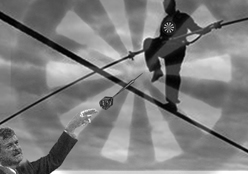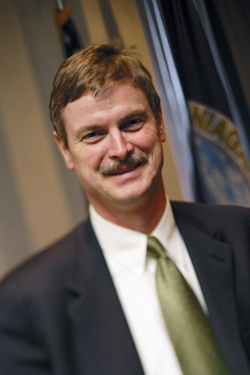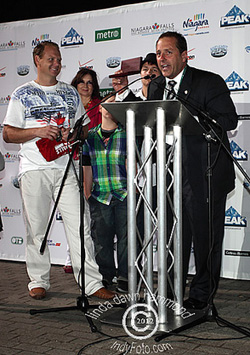Spree Magazine Erroneously Credits Dyster for Wallenda Walk
By Frank Parlato
The January edition of Buffalo Spree magazine had a most telling article and an interview with Niagara Falls Mayor Paul A. Dyster.
The Spree article duly reports that Dyster "was an early advocate for allowing Nik Wallenda to tightrope across Niagara Falls," and it quotes Dyster as saying "I think we scored one of the biggest public relations triumphs in the history of Niagara Falls over the course of that weekend. Both sides of the Falls saw about 150,000 people, who witnessed the event firsthand. Somewhere between 13 million and 16 million people watched it on ABC that night."
Spree, a normally striking magazine, filled as it is with engaging articles and colorful pictures of local interest, apparently loves Dyster and has, candidly, periodically run adoring pieces on him.
Still adoring or not, for them to say he was an "early advocate" of the Wallenda walk and for Dyster to use the word "we," in the above quote, is so inaccurate and, in the case of Dyster, so hypocritical that we are honor bound to show clear and convincing proof that Dyster was against the Wallenda walk from day one.
If it were up to him, it would not have happened.
Instead of assuming a positive role, the chief executive of the City of Niagara Falls was the voice of criticism.
From around the world, the press reported an otherwise unanimous and positive chorus of praise and hope from local officials about the Wallenda walk.
In fact, a search of hundreds of news stories shows only one consistent voice of negativity.
For example, a year before the Wallenda walk, CKTB News (June 23, 2011) reported that Mayor Paul Dyster "does worry about the repercussions of a high wire act over the Falls. Dyster says while Wallenda is a trained professional, he may encourage amateur stunters to attempt the feat, attempts he says will almost certainly end badly.”
The LA Times wrote, “Skeptics such as Mayor Paul Dyster of Niagara Falls, N.Y., worry about copycats…. 'We're also concerned about our first responders who would have to go and rescue people,’ Dyster said."
The New York Post reported on July 5, 2011: “Dyster has said his economically struggling city needs to take into account concerns that the event could be perceived as a ‘sideshow’ to the falls.”
CKTB reported again, “Dyster says respect must also be paid to the Falls themselves. He doesn't want (the Wallenda walk to become) a ‘sideshow’ ...that he worries (the Wallenda walk) would take away from (the Falls') elegance and beauty. Dyster's stance doesn't line up with that of his Canadian counterpart (Niagara Falls Mayor Jim Diodati, who supports the proposed walk).”
After raising objections about first responders, copycats and how the walk would "disrespect" the falls, on Oct. 28, 2011, the Buffalo News wrote of a new concern, the possibility of lawsuits from other daredevils. “Mayor Paul A. Dyster said, ‘The one concern I had about this is that because Wallenda was the only (tightrope walker) who was offered this opportunity, and he has competitors, you just want to be careful there’s not a conflict of interest here.’”
His next concern was there might be too many wire walkers.
“If this occurs often, it cheapens the real attraction," said Dyster, in the Buffalo News, February 19, 2012.
Throughout the winter and spring of 2012, Dyster made no plans to promote and organize for the event, and refused to go to Wallenda's meetings to help organize ways to capitalize on this event.
In fact, he expressed worry that Niagara Falls would get too many people and told the media he wanted to change the date to the winter or fall.
“Niagara Falls Mayor Paul Dyster says, (the Wallenda walk) could all backfire,” reported WIVB News on May 2. “‘If we don't have rooms to sell to people, then the benefit is less. To us, to do it off of peak helps us,’ said the mayor.”
As the walk came closer to reality, Mayor Dyster suggested that it might end in tragedy. He told the Buffalo News, “’I think the story line is man versus Mother Nature,’" he said, pointing out that it's no secret people have fallen to their deaths at the falls, either in accidents or in suicides.
"'If Mother Nature wins, maybe, in a way, that heightens the mystery of the falls,' Dyster said. He quickly added: 'I'm not suggesting I'm rooting against him.'”
He also expressed worry about Frederick Law Olmsted, who designed the Niagara Falls Reservation.
Don Glynn wrote in the Niagara Gazette, on May 3, 2012: “By the way, it shouldn't have come as any surprise that Mayor Paul A. Dyster was missing from VIPs at the (Wallenda) press session. It is common knowledge that Dyster was opposed to the Wallenda walk from the outset. The mayor, a staunch preservationist, is a firm advocate of Frederick Law Olmsted, the landscape architect whose 1880’s plan was to preserve the beauty of the falls and surrounding parklands.”
Last month, Buffalo Spree quoted Dyster on the Wallenda walk: "I think we scored one of the biggest public relations triumphs in the history of Niagara Falls over the course of that weekend."
We?
Let us all salute the great entrepreneur and promoter Roger Trevino, State Assemblyman John Ceretto, State Sen. George Maziarz, Niagara Falls, Ont., Mayor Jim Diodati, and, of course, the great Nik Wallenda, who are the ones who really made this event a success, despite Mayor Dyster's objections.



